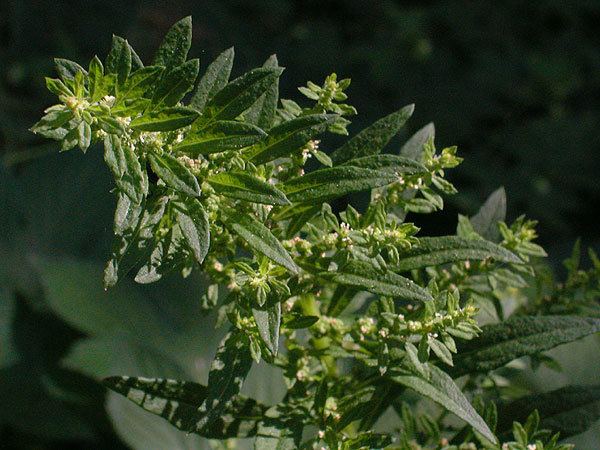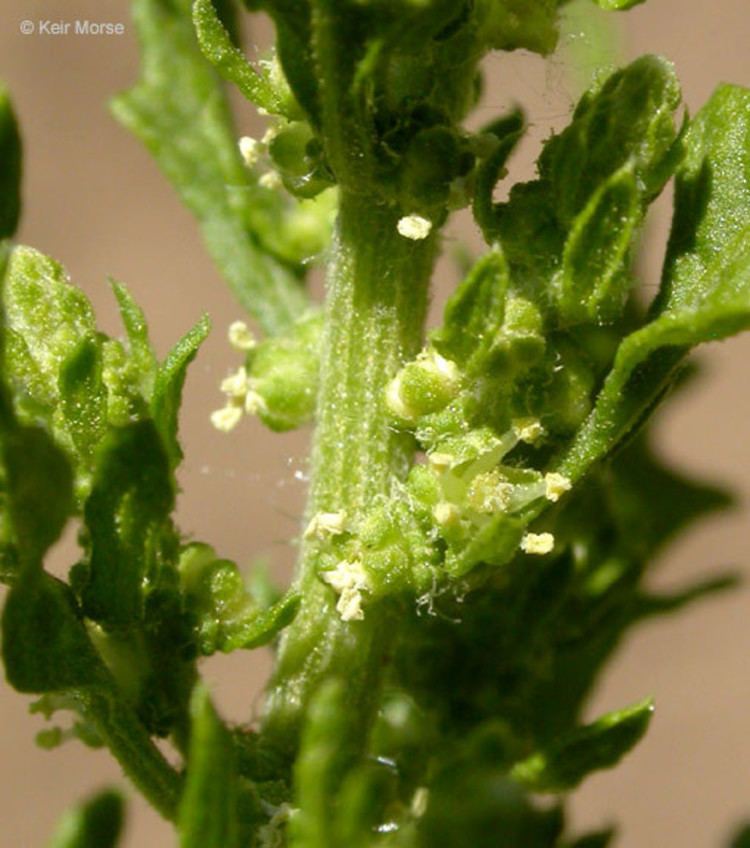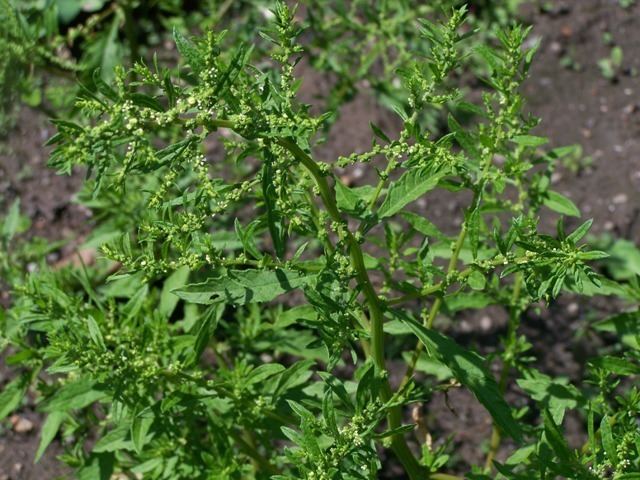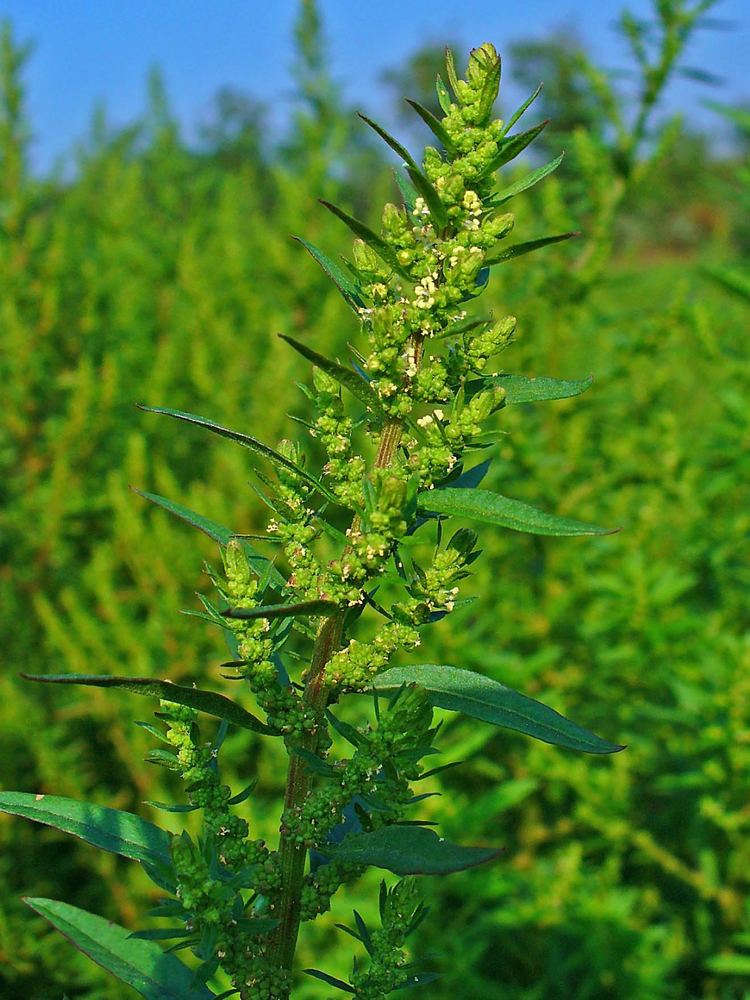Tribe Dysphanieae | Subfamily Chenopodioideae Genus Dysphania Rank Species | |
 | ||
Similar Water, Piper auritum, Elote, Guajillo chili, Boldo | ||
Germina epazote dysphania ambrosioides y propiedades
Dysphania ambrosioides, formerly Chenopodium ambrosioides, known as wormseed, Jesuit's tea, Mexican-tea, payqu (paico), epazote, or herba sancti Mariæ, is an annual or short-lived perennial herb native to Central America, South America, and southern Mexico.
Contents
- Germina epazote dysphania ambrosioides y propiedades
- Growth
- Taxonomy
- Etymology
- Culinary uses
- Use in medicine
- Toxicity
- Agricultural use
- Companion plant
- Chemical constituents
- References

Growth

D. ambrosioides is an annual or short-lived perennial plant (herb), growing to 1.2 m (3.9 ft) tall, irregularly branched, with oblong-lanceolate leaves up to 12 cm (4.7 in) long. The flowers are small and green, produced in a branched panicle at the apex of the stem.

As well as in its native areas, it is grown in warm temperate to subtropical areas of Europe and the United States (Missouri, New England, Eastern United States), sometimes becoming an invasive weed.
Taxonomy

The generic name Dysphania traditionally was applied in the 1930s to some species endemic to Australia. Placement and rank of this taxon have ranged from a mere section in Chenopodium to the sole genus of a separate family Dysphaniaceae, or a representative of Illicebraceae. The close affinity of Dysphania to "glandular" species of Chenopodium sensu lato is now evident.
Etymology

The common Spanish name, epazote (sometimes spelled and pronounced ipasote or ypasote), is derived from Nahuatl: epazōtl (pronounced [eˈpasoːt͡ɬ]) meaning skunk sweat.
Culinary uses

D. ambrosioides is used as a leaf vegetable, herb, and herbal tea for its pungent flavor. Raw, it has a resinous, medicinal pungency, similar to oregano, anise, fennel, or even tarragon, but stronger. The fragrance of D. ambrosioides is strong but difficult to describe. A common analogy is to turpentine or creosote. It has also been compared to citrus, savory, and mint.
Although it is traditionally used with black beans for flavor and its supposed carminative properties (less gas), it is also sometimes used to flavor other traditional Mexican dishes as well: it can be used to season quesadillas and sopes (especially those containing huitlacoche), soups, mole de olla, tamales with cheese and chili peppers, chilaquiles, eggs and potatoes and enchiladas. It is often used as an herb in white fried rice and an important ingredient for making the green salsa for chilaquiles.
Use in medicine
In the early 1900s, D. ambrosioides was used as an anthelmintic to treat ascarids and hookworms in humans, cats, dogs, horses, and pigs. Usually, oil of chenopodium was used. It was sometimes referred to as Baltimore Oil, because of the large production facility in Baltimore, Maryland that specialized in extracting the oil from the plant. Chenopodium was replaced with other, more effective and less toxic anthelmintics in the 1940s.
Chenopodium is still used to treat worm infections in humans in many countries. In Honduras, as well as other Latin American countries, the whole plant or the leaves are ground and added to water. This mixture is then consumed. In a few areas in Latin America, the plant also is used to treat worm infections in livestock.
D. ambrosioides is believed to prevent flatulence. It has also been used for amenorrhea, dysmenorrhea, malaria, chorea, the now discredited diagnosis of hysteria, catarrh, and asthma.
Toxicity
Overdoses of the essential oil have caused human deaths (attributed to the ascaridole content). The symptoms including severe gastroenteritis with pain, vomiting, and diarrhoea.
Agricultural use
The essential oils of D. ambrosioides contain terpene compounds, some of which have natural pesticide capabilities. The compound ascaridole in epazote inhibits the growth of nearby plants, so it would be best to relegate this plant at a distance from other inhabitants of the herb garden. Even though this plant has an established place in recipes and in folklore, it is wise to use only the leaves, and those very sparingly, in cooking.
Companion plant
D. ambrosioides not only contains terpene compounds, but it also delivers partial protection to nearby plants simply by masking their scent to some insects, making it a useful companion plant. Its small flowers may also attract some predatory wasps and flies.
Chemical constituents
Some of its chemical constituents have been shown in the laboratory to affect certain cancer cell lines, and it has also been reported to be highly carcinogenic in rats. A Nigerian group, however, concluded in 2007 that it is neither mutagenic nor cytotoxic.
Oil of chenopodium is derived from this plant. Merriam-Webster defines it as "a colorless or pale yellow toxic essential oil of unpleasant odor and taste, ... formerly used as an anthelmintic".
Epazote essential oil contains ascaridole (up to 70%), limonene, p-cymene, and smaller amounts of numerous other monoterpenes and monoterpene derivatives (α-pinene, myrcene, terpinene, thymol, camphor and trans-isocarveol). Ascaridole (1,4-peroxido-p-menth-2-ene) is rather an uncommon constituent of spices; another plant owing much of its character to this monoterpene peroxide is boldo. Ascaridole is toxic and has a pungent, not very pleasant flavor; in pure form, it is an explosive sensitive to shock. Ascaridole content is lower in epazote from Mexico than in epazote grown in Europe or Asia.
